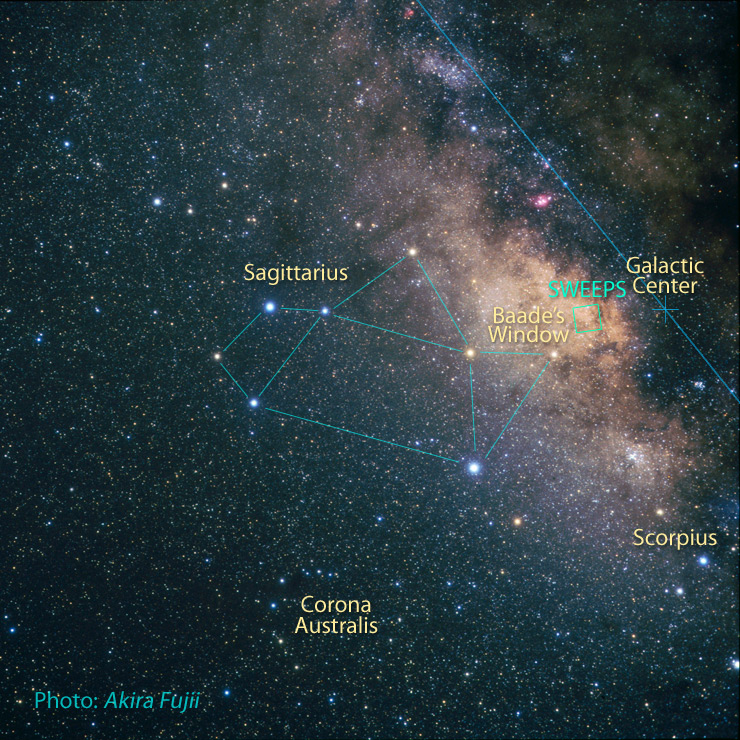Sagittarius Window Eclipsing Extrasolar Planet Search on:
[Wikipedia]
[Google]
[Amazon]
The Sagittarius Window Eclipsing Extrasolar Planet Search, or SWEEPS, was a 2006

 The stars that were monitored in this
The stars that were monitored in this
News Release Number: STScI-2006-34 Hubble Finds Extrasolar Planets Far Across Galaxy
{{Portal bar, Astronomy, Stars, Spaceflight, Outer space Sagittarius (constellation) Astronomical surveys Exoplanet search projects Hubble Space Telescope
astronomical survey
An astronomical survey is a general celestial cartography, map or astrophotography, image of a region of the sky (or of the whole sky) that lacks a specific observational target. Alternatively, an astronomical survey may comprise a set of image ...
project using the Hubble Space Telescope
The Hubble Space Telescope (HST or Hubble) is a space telescope that was launched into low Earth orbit in 1990 and remains in operation. It was not the Orbiting Solar Observatory, first space telescope, but it is one of the largest and most ...
's Advanced Camera for Surveys - Wide Field Channel to monitor 180,000 stars for seven days to detect extrasolar planet
An exoplanet or extrasolar planet is a planet outside the Solar System. The first confirmed detection of an exoplanet was in 1992 around a pulsar, and the first detection around a main-sequence star was in 1995. A different planet, first detect ...
s via the transit method
Methods of detecting exoplanets usually rely on indirect strategies – that is, they do not directly image the planet but deduce its existence from another signal. Any planet is an extremely faint light source compared to its parent star. For e ...
.
Area examined

 The stars that were monitored in this
The stars that were monitored in this astronomical survey
An astronomical survey is a general celestial cartography, map or astrophotography, image of a region of the sky (or of the whole sky) that lacks a specific observational target. Alternatively, an astronomical survey may comprise a set of image ...
were all located in the Sagittarius-I Window. The Sagittarius Window is a rare view to the Milky Way
The Milky Way or Milky Way Galaxy is the galaxy that includes the Solar System, with the name describing the #Appearance, galaxy's appearance from Earth: a hazy band of light seen in the night sky formed from stars in other arms of the galax ...
's central bulge stars: our view to most of the galaxy's central stars is generally blocked by lanes of dust. These stars in the galaxy's central bulge region are approximately 27,000 light year
A light-year, alternatively spelled light year (ly or lyr), is a unit of length used to express astronomical distance, astronomical distances and is equal to exactly , which is approximately 9.46 trillion km or 5.88 trillion mi. As defined by t ...
s from Earth.
Planets discovered
Sixteen candidate planets were discovered with orbital periods ranging from 0.6 to 4.2day
A day is the time rotation period, period of a full Earth's rotation, rotation of the Earth with respect to the Sun. On average, this is 24 hours (86,400 seconds). As a day passes at a given location it experiences morning, afternoon, evening, ...
s. Planets with orbital periods less than 1.2 days have not previously been detected, and have been dubbed "ultra-short period planet
An ultra-short period (USP) planet is a type of exoplanet with an orbital period of less than one Earth day. At this short distance, tidal interactions lead to relatively rapid orbital and spin evolution. Therefore when there is a USP planet arou ...
s" (USPPs) by the search team. USPPs were discovered only around low-mass stars, suggesting that larger stars destroyed any planets orbiting so closely or that planets were unable to migrate as far inward around larger stars.
Planets were found with roughly the same frequency of occurrence as in the local neighborhood of Earth.
SWEEPS-4 and SWEEPS-11 orbited stars that were sufficiently visually distinct from their neighbors that follow-up observations using the radial velocity method
Doppler spectroscopy (also known as the radial-velocity method, or colloquially, the wobble method) is an indirect method for finding extrasolar planets and brown dwarfs from radial-velocity measurements via observation of Doppler shifts in th ...
were possible, allowing their masses to be determined.
This table is constructed from information obtained from the Extrasolar Planets Encyclopedia
The Extrasolar Planets Encyclopaedia (also known as Encyclopaedia of exoplanetary systems and Catalogue of Exoplanets) is an astronomy website, founded in Paris, France at the Meudon Observatory by Jean Schneider (Extrasolar Planets Encyclopaedia) ...
and SIMBAD
SIMBAD (the Set of Identifications, Measurements and Bibliography for Astronomical Data) is an astronomy, astronomical database of objects beyond the Solar System. It is maintained by the Centre de données astronomiques de Strasbourg (CDS), Fr ...
databases that reference the ''Nature'' article as their source.
See also
* Baade's Window *Optical Gravitational Lensing Experiment
The Optical Gravitational Lensing Experiment (OGLE) is a Polish astronomy, astronomical project based at the University of Warsaw that runs time-domain astronomy, a long-term variability sky survey (1992–present). The main goals are the detecti ...
or ''OGLE'' also examines the galactic bulge
In astronomy, a galactic bulge (or simply bulge) is a tightly packed group of stars within a larger star formation. The term almost exclusively refers to the group of stars found near the center of most spiral galaxies (see ''galactic spheroid'' ...
for planets.
References
External links
News Release Number: STScI-2006-34 Hubble Finds Extrasolar Planets Far Across Galaxy
{{Portal bar, Astronomy, Stars, Spaceflight, Outer space Sagittarius (constellation) Astronomical surveys Exoplanet search projects Hubble Space Telescope